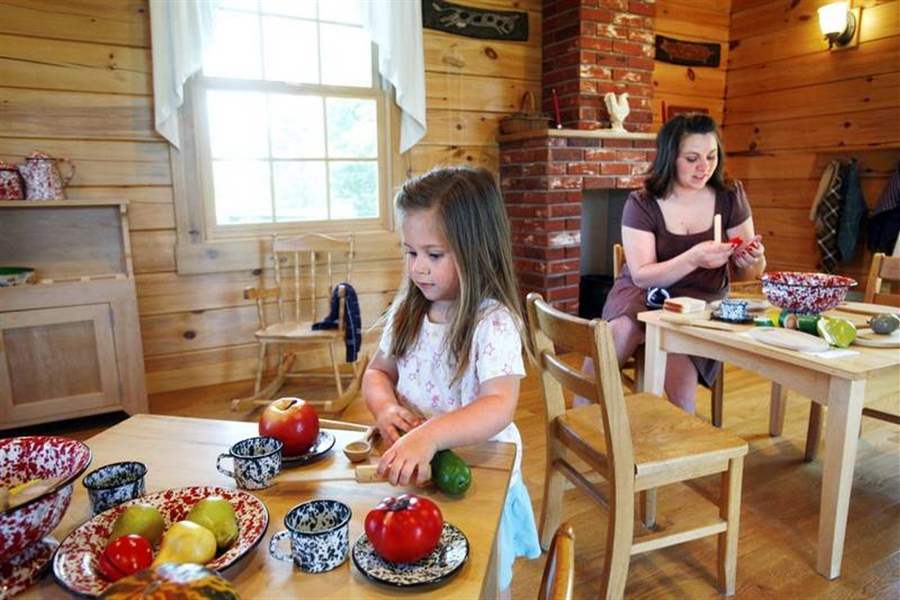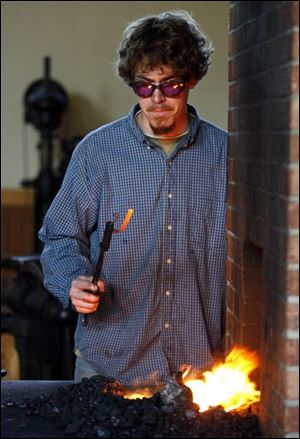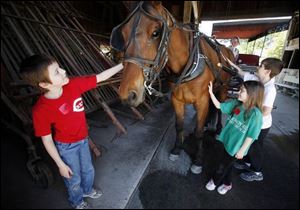
Playing pioneer: Sauder Village opens window to region's past
5/26/2008
Emilia Braman, 2, and her mother, Autumn, of Battle Creek, Mich., settle into Sauder Village's Little Pioneers Homestead, which includes a cabin and barn with furnishings aimed at the stroller crowd.

Emilia Braman, 2, and her mother, Autumn, of Battle Creek, Mich., settle into Sauder Village's Little Pioneers Homestead, which includes a cabin and barn with furnishings aimed at the stroller crowd.
Sticking close to home this summer? A new feature, Short Stops, will help steer readers toward day trips that won't burn the tank of gas. Short Stops will appear each Monday throughout the summer.
ARCHBOLD, Ohio - A youngster dashes into the barn, calling to his classmates. "Oh, sweet. Look, it's a baby "
He stops. Um, a baby what, he asks rather sheepishly.
The black-as-coal coat on the little lamb throws off the barnyard animal-recognition skills of some visitors at Sauder Village, a place where you can wash clothes on a scrub board, stitch together a broom, and lean into a wooden pen to pet a newborn lamb.

Sauder Village blacksmith Simon Tomell forges flint strikers, used to spark fires.
Each season, the living-history village throws open a window into the frontier world of yesterday.
From the conductor yelling "All Aboard!" at the depot to the village blacksmith forging a flint striker, the pioneer past chugs, clangs, clicks, and clucks.
Each year, about 100,000 people visit the village at the edge of Archbold in western Fulton County.
"We hope the number grows this year," said Jeanette Smith, the village's director of sales and marketing.
New events, programs, and activities crop up regularly on the land where nearly four decades ago Erie Sauder first announced his vision of a place where the past could be preserved for the future, a place where people could learn about what life was like when pioneers settled the area known as the Great Black Swamp.

Trevor Lacey, 10, left, and his siblings, Heather, 7, and Trent, 8, pet a horse before going for a carriage ride at Sauder Village, where they were visiting with their parents, Troy and Ruth. The Lacey family is from western Wood County s Bradner.
Mr. Sauder, who in 1934 founded the Sauder Woodworking Co., today a world leader in ready-to-assemble furniture, was fond of telling stories about his ancestors who were among the original settlers of this area.
To keep those stories as well as the history of the region alive, Mr. Sauder in the 1970s had dozens of structures, built by hand a century earlier, moved from locations throughout northwest Ohio to create the Sauder Village.
Today, the third generation of his family oversees the village, which includes a 350-seat restaurant, bakery, campground, 98-room inn, and an exhibition hall/performance center.
The village billed as Ohio's largest living-history destination features a farm and gardens, a Native American area, daily demonstrations by craftsmen, and hands-on experiences.
On a recent school day, the village buzzed with bus loads of youngsters scampering from shop to shop.
The hands-on, hands-down favorite: the General Store, filled to the rafters with toys, trinkets, and treasures from days gone by (jacks, dominoes, chickweed salve, tin wind-up toys, wooden rolling pins, cookie presses, jawbreakers, calico bonnets).
"Years ago, it would take families a day to travel to the general store where they brought along things to barter. The mother would bring eggs and baked goods and the father would bring shingles to barter for seeds," said Joan Connolly, of West Unity in neighboring Williams County, as she rang up school children's purchases - a purple rabbit's foot, a coin purse, a sack of cat's-eye marbles.
"People would come to the general store to vote, to get their mail, and to socialize. Children loved to get candy, but they were careful not to eat it too quickly. They would take a couple licks of their lollipop from time to time, and then put it away to savor it longer. That candy was special."
The general store is fashioned after the store that "Mr. Sauder knew as a young boy," Mrs. Connolly said.
Today, she said, school kids are surprised to learn that children 100 years ago only got one pair of new shoes a year. "Now days, a place like this is really fascinating to the children."
The day before, an entire class bought bags of marbles. "Their teacher was going to teach them how to play marbles. The kids were so excited. They had such a good time just picking out the marbles," Mrs. Connolly said.
Third-grade student Finn Haughn, who attends school in Liberty Center in nearby Henry County, was looking forward to a ride on the Erie Express train which leaves from the depot south of the Museum Building where potato diggers, hand-pushed hay rakes, and a horse-drawn manure spreader remind visitors that pioneer life was real, and it was rustic.
During the train ride this summer, guests will be able to see crews working on the new Pioneer Settlement Area, the next phase of the village's Historic Time Line Project.
Workers will be setting buildings on foundations and working on restoration or historic structures. Later this summer, guests will be able to see a pioneer wagon that will be part of the display.
Special events this season include a doll and teddy bear show and sale, a traditional rug-hooking exhibit, apple butter making week, a woodcarvers' show and sale, and a fiddle contest.
The village's hands-on activities underline the fact that children today are often generations removed from life on the farm.
During Sauder's traditional farm days, visitors of all ages can learn about life in Ohio more than 100 years ago and experience how activities on the farm changed with the season - planting seeds for crops in the spring, plucking feathers from a goose in the summer, and making cornhusk dolls in the fall.
On this day, as the delicate scent of lilacs drifted across the village green, field trip chaperones steered students away from a pond.
"There's a fish!" Jonathan Giesige, a fifth grader at Hicksville Elementary School, shouted to his classmates, scooting down the embankment to get a closer look at the fish, frogs, and cattails.
Another shout goes up. "Look, let's go see the cow!"
Um, OK. But it's not a real one as the youngsters find out as they approach the black-and-white, life-sized figure.
But inside a nearby barn, where bales of sweet-smelling hay are stacked in the loft, there are some very real pigs, a calf the color of a well-worn saddle, and those black-as-coal lambs, waiting for the next batch of visitors to reach out and touch the past.
Contact Janet Romaker at:
jromaker@theblade.com
or 419-724-6006.